For balanced soap formulations, aim for 50-60% hard oils (coconut, palm) for firmness and lather, 30-40% soft oils (olive, sweet almond) for conditioning, and 5-10% castor oil to stabilize lather. Keep coconut oil at 20-30% to avoid over-cleansing, and consider superfatting at 5-8%. You'll want butters under 20% and specialty oils at 5-10% for cost efficiency. These proportions guarantee your soap delivers the perfect combination of cleansing, moisturizing, and lathering properties.
What Soap Oil Ratios Should You Actually Use?
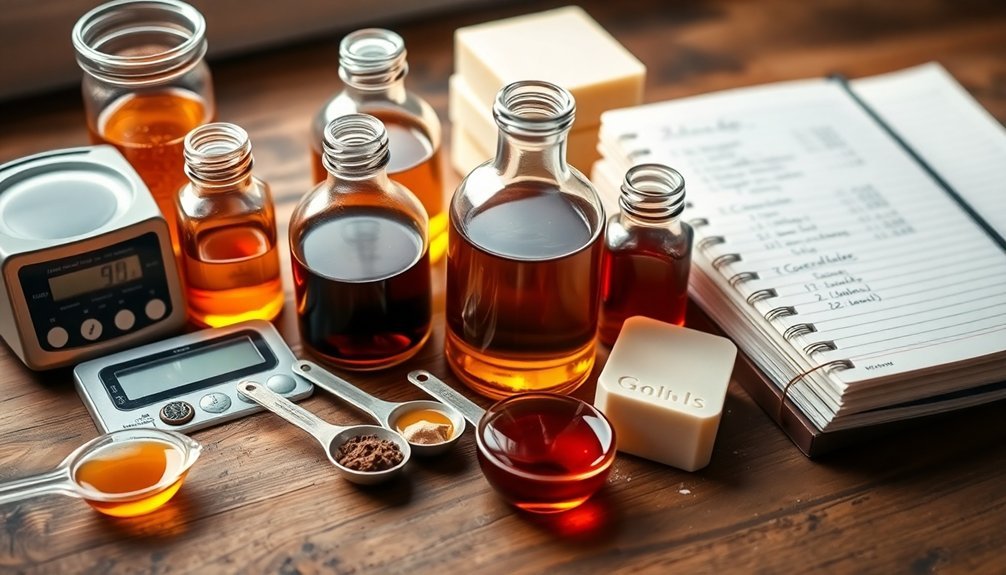
When formulating your own soap recipe, finding the right balance of oils is essential for creating a bar that's both functional and enjoyable to use. Aim for at least 50% solid oils (like palm or cocoa butter) to guarantee a hard bar of soap with lasting lather.
Include 20-30% coconut oil for excellent cleansing properties and abundant bubbles, while limiting liquid oils to 10-30% of your formula. Olive oil makes an excellent liquid oil choice for its moisturizing benefits.
Don't forget to add 5-10% castor oil to enhance lather quality without making your soap sticky. For ideal skin care, consider superfatting at 5-8% to leave beneficial unreacted oils in your final product.
A balanced soap recipe might follow a 30:30:40 ratio (coconut:olive:other oils) for a perfect cleansing-moisturizing balance.
The Science Behind Balanced Oil Ratios
Understanding the chemistry behind soap making reveals why balanced oil ratios are essential for creating effective soap. Each oil contributes specific properties through its unique fatty acid profile.
| Oil Type | Key Contribution |
|---|---|
| Coconut oil | Strong cleansing, fluffy lather |
| Olive oil | Conditioning, mild cleansing |
| Palm oil | Bar hardness, stable lather |
| Sweet almond | Moisturizing, gentle feel |
| Castor oil | Lather stability, humectant |
Hard oils (coconut, palm) should comprise at least 50% of your recipe to create a firm bar with good lather. The remaining percentage should come from conditioning oils like olive oil to prevent dryness. When using higher percentages of cleansing oils, you'll need to increase your superfatting level to maintain skin-friendliness.
Your goal is balancing these properties—too much cleansing without conditioning creates harsh soap, while too little creates soft bars with poor lather.
Hard vs. Soft Oils: Finding Your Perfect Percentage
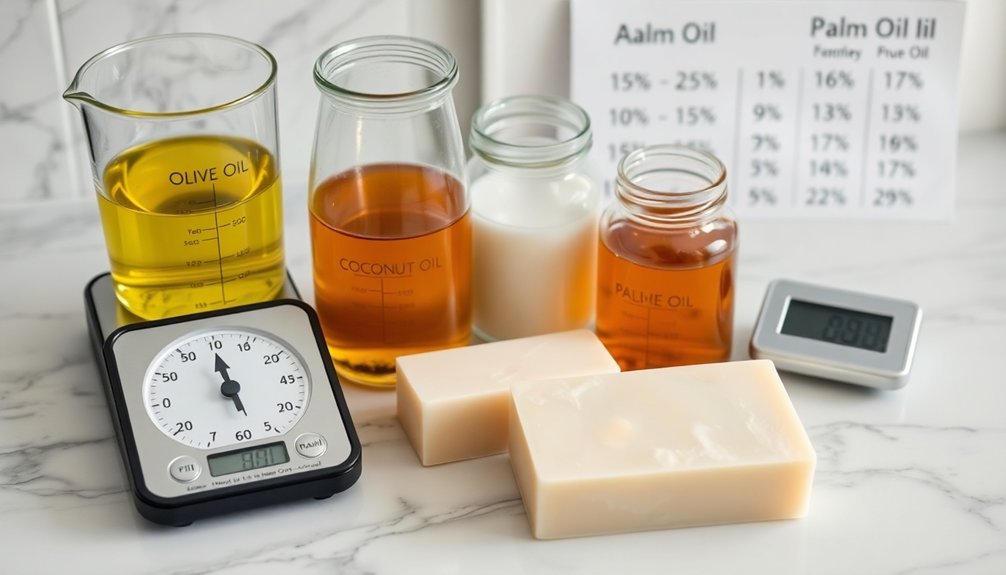
Every successful soap recipe relies on balancing hard and soft oils to achieve the ideal bar.
You'll want to include at least 50% hard oils like coconut and palm to guarantee firmness, good cleansing properties, and stable lather in your finished soap.
Complement these with soft oils such as olive and sweet almond oil, which deliver moisturizing effects but should be limited to 50% or less of your recipe to maintain proper hardness.
Most balanced formulations contain 30-60% hard oils paired with 40-70% soft oils, creating a bar that both cleanses and nourishes.
Castor oil deserves special attention—use this soft oil sparingly (5-10%) to boost lather without creating stickiness.
Don't hesitate to experiment with different ratios until you find the perfect balance for your ideal soap.
Essential Fatty Acid Profiles for Soap Quality
The secret behind a perfectly balanced soap lies in its fatty acid composition.
When formulating your recipe, aim for a 60:40 ratio of saturated to unsaturated fatty acids to achieve ideal soap quality. Your soap's character comes directly from the essential fatty acids present in your oils.
- Lauric acid from coconut oil soap creates hardness and cleansing properties
- Myristic acid contributes to that fluffy, bubbly lather you love
- Palmitic acid (found in hard oils) develops stable, creamy lather
- Linoleic acid from soft oils like grapeseed produces silky, moisturizing bars
- Oleic acid from oils like olive balances the formula with conditioning properties
How to Calculate Your Solid-to-Liquid Oil Balance
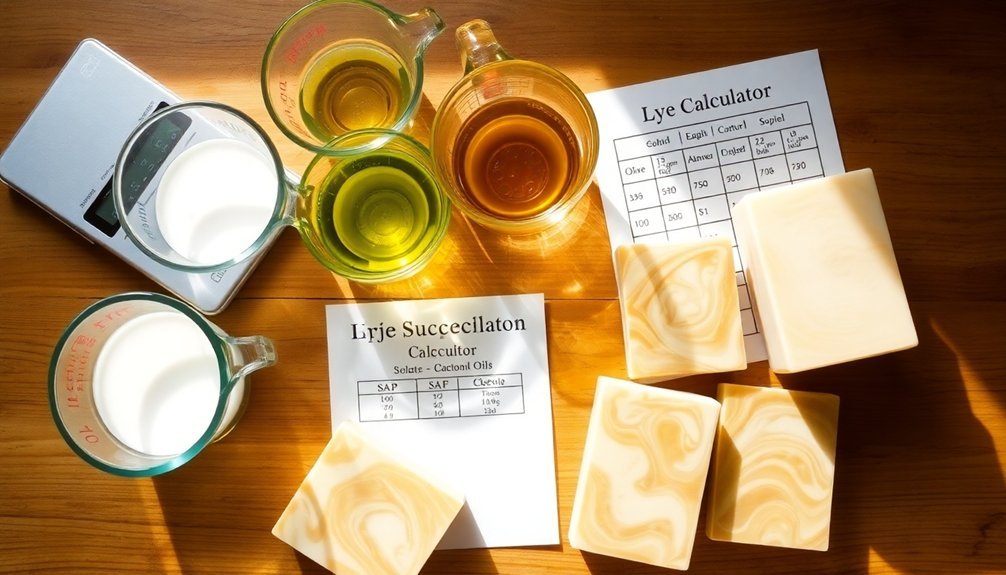
While crafting the perfect soap requires artistry, achieving the ideal solid-to-liquid oil balance demands precision and calculation.
Begin by aiming for at least 50% solid oils in your soap formulation to guarantee proper hardness and longevity.
To calculate your balance, identify which oils solidify at room temperature (coconut, palm, cocoa butter) versus those that remain liquid (olive, sweet almond).
For beginners, a 60:40 ratio of hard to soft oils provides reliable results.
Remember that each oil's saponification value determines the exact lye amount needed. Use an online calculator to guarantee accurate measurements based on your specific ingredients.
You can adjust ratios to achieve desired properties—increase coconut oil for better lather or add more liquid oils for extra moisture.
This balance becomes the foundation of your soap's performance and texture.
Butter Incorporation: Optimal Amounts for Luxury Bars
When working with butters in your soap recipe, you'll want to keep them at or below 20% of your total oil weight to strike the perfect balance between luxurious texture and effective lathering.
Your goal is to harness butters' hardening properties without creating a greasy bar that feels sticky or performs poorly.
Tempering your butters before incorporation and maintaining at least 50% solid oils in your formula will guarantee your luxury bars deliver both the indulgent feel and functional performance your customers expect.
Balancing Hard vs. Soft
Creating luxury soap bars requires a delicate balance between hard and soft oils, with butters playing a crucial role in achieving that perfect harmony.
When crafting your soap recipe, you'll want to maintain the right proportions to guarantee both cleansing ability and moisturizing properties.
- Aim for at least 50% hard oils to guarantee proper soap hardness and stable lather
- Keep butters (like shea or cocoa) between 5-15% of your formula, not exceeding 20%
- Consider a 60/40 ratio of hard to soft oils for well-rounded performance
- Use hard oils like palm and coconut for structure and cleansing
- Incorporate soft oils like olive oil to enhance conditioning without compromising stability
This balanced approach delivers bars that clean effectively while keeping skin nourished—the hallmark of truly luxurious handmade soap.
Texture Without Greasiness
Luxury soap bars achieve their distinctive creamy texture through the strategic incorporation of butter—without sliding into greasiness. By limiting butters to 20% of your total oil weight, you'll enhance moisturizing properties while maintaining structural integrity.
| Butter Type | Benefits for Soap |
|---|---|
| Shea | Ideal for sensitive skin |
| Cocoa | Adds firmness and stability |
| Mango | Creates silky texture |
| Avocado | Enhances creaminess |
| Kokum | Provides hardness balance |
Pair these butters with at least 50% hard oils to create a balanced soap that's both firm and luxurious. This combination delivers a stable, creamy lather that feels rich without leaving residue. Your customers with dry or sensitive skin will particularly appreciate this thoughtful formulation that delivers indulgence without heaviness.
Specialty Oil Considerations: When Less Is More
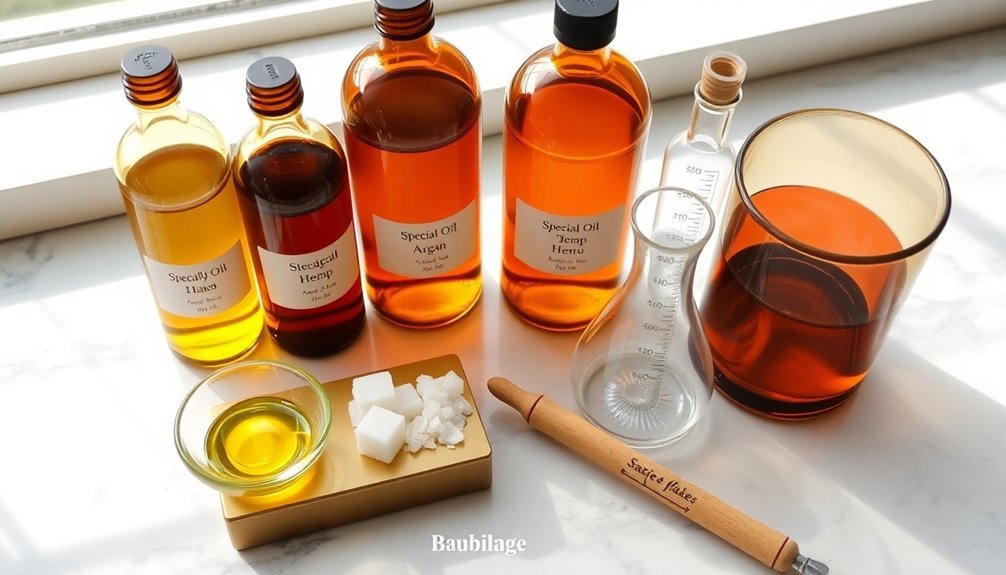
You'll find that specialty oils work best in small percentages, typically 5-10% of your total oil weight, where they can enhance lather and skin benefits without creating sticky soap or breaking your budget.
When working with expensive oils like evening primrose or macadamia nut, limiting them to 5-15% maximizes their luxury benefits while maintaining proper soap hardness and extending shelf life.
This measured approach strikes the perfect balance between capturing the unique properties of specialty oils and creating an economical, high-performing soap formula.
Specialty Oil Ratios
Why do specialty oils demand such careful measurement in soap making?
These luxurious ingredients bring exceptional qualities to your soap, but they require precision to maintain balance in your formulation.
For ideal results, follow these guidelines:
- Keep specialty oils like jojoba, avocado, and kukui nut at 5-10% to preserve lathering properties while adding their unique benefits.
- Limit castor oil to 5-10% to enhance lather without creating sticky bars.
- Use borage oil at only 3-5% to harness its rich fatty acids without compromising bar hardness.
- Incorporate high-fat oils like hemp seed or evening primrose at 10-20% to maintain balanced shelf life.
- Restrict butters such as shea or cocoa to 15-20% of total oil weight to boost moisturizing properties while ensuring firmness.
These ratios will help you craft exceptional soaps that maintain quality while showcasing specialty ingredients.
Cost vs. Benefit Analysis
When evaluating specialty oils for soap making, calculating their true value requires looking beyond the price tag. Ask yourself what each oil contains that justifies its higher cost—is it unique fatty acids, antioxidants, or vitamins that create an ideal soap?
Instead of using a high percentage of expensive avocado or hemp seed oil, consider incorporating them at just 10-20% of your total recipe. This approach maximizes their benefits while keeping costs reasonable.
For example, a bar using 100% olive oil costs about $1.50, but delivers excellent conditioning.
Your recipe based on cost-efficient workhorses like olive and castor oils, complemented by strategic amounts of specialty oils, creates balance between quality and affordability.
Analyze how oils in a soap contribute to lather, hardness, and skin benefits to determine if they're worth the investment.
Frequently Asked Questions
What Is the Ratio of Essential Oils to Soap?
You'll want to use essential oils at 0.5% to 5% of your soap's total oil weight. That's 5-50 grams for a 1000-gram batch, adjusting for potency – less for strong oils like peppermint.
What Is the Ratio for Soap Mixing?
For soap mixing, you'll want 50-75% hard oils and 25-50% soft oils. Use 20-30% coconut oil for bubbles, up to 100% olive oil for gentleness, and 5-10% castor oil for lather. Superfat at 5-8% for moisturizing benefits.
What Percentage of Fragrance Oil Should Be in Soap?
You should use 5-10% fragrance oil based on your total oil weight. That's 50-100g for a 1kg batch. Don't exceed 10% as it may prevent proper setting and cause skin irritation.
What Is the Best Super Fat Percentage for Soap Making?
You'll want to aim for a superfat percentage between 5-8% for ideal results. Use 5% for recipes with cleansing oils like coconut, and up to 8% with gentler oils like olive or avocado.
In Summary
You've now got the knowledge to craft your perfect soap bars with balanced oil ratios. Remember, there's no one-size-fits-all formula—aim for 60-80% hard oils for durability, 20-40% soft oils for conditioning, and 5-10% luxury butters for that special touch. Trust your calculations, but don't be afraid to experiment. Your ideal soap is waiting at the intersection of science and your personal preferences.

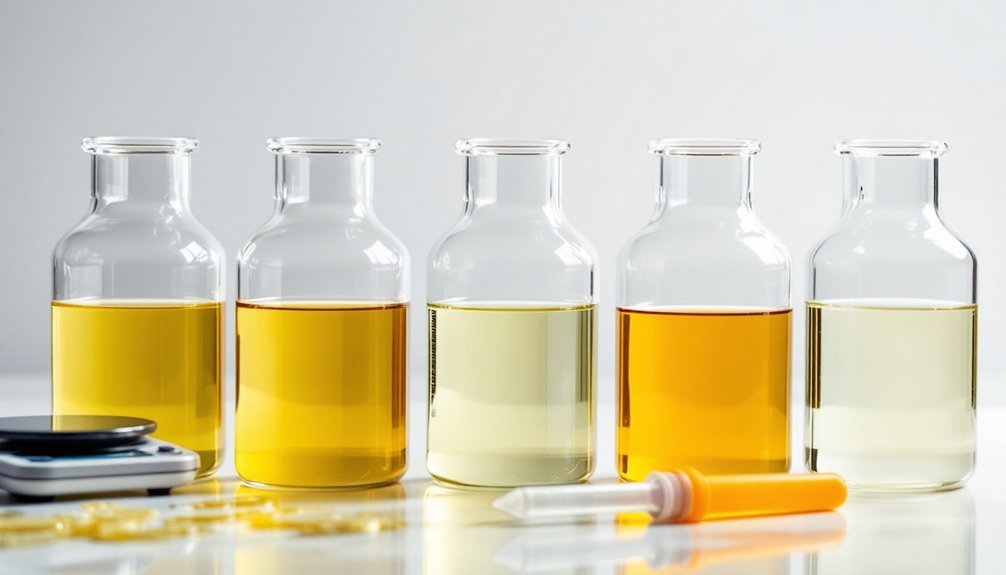



Leave a Reply